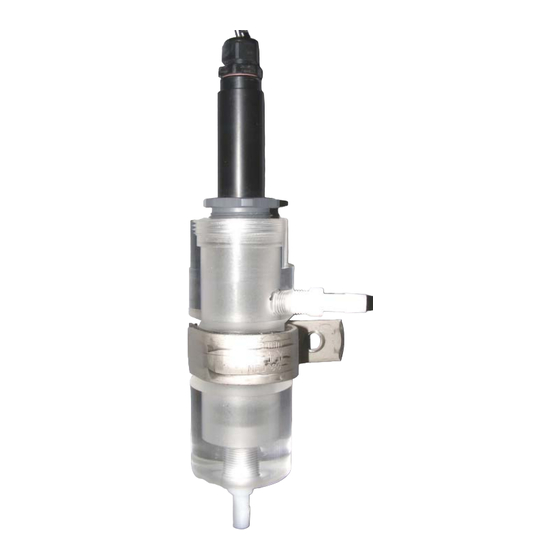
Table of Contents
Advertisement
Quick Links
SECTION 1.0
THEORY OF OPERATION
1.0 FREE CHLORINE DEFINED. Free Chlorine or "freely active chlorine"
is defined as the sum of molecular chlorine (Cl 2 ), hypochlorous acid
(HOCl) and hypochlorite ions (OCl - ). Molecular chlorine occurs at
pH values <pH4. Hypochlorus acid and hypochlorite ions are in pH
dependent equilibrium with one another as shown in FIG 1.
The graph shows % hypochlorous acid on the left of the curve.
Hypochlorous acid is a much stronger disinfecting agent (oxidizer) as
compared to hypochlorite ions.
1.2 SENSOR OPERATING PRINCIPLE. Both hypochlorous acid (HOCl)
and hypochlorite ion (OCl-) diffuse through the membrane between
the cathode and sample solution, even though the diffusion coeffi-
cients for each are different. At the applied potential, only hyphochlo-
rous acid is electrochemically reduced. HOCl is reduced to chloride
ion at the gold cathode. At the same time, the silver anode is oxidized
to form silver chloride (AgCl). When the concentration of HOCl at
the cathode is dramatically decreased by electrochemical reduction,
hypochlorite ion will be transformed into hypochlorous acid , to some
extent, by proton transfer. The release of electrons at the cathode
and acceptance at the anode creates a current flow, which under
constant conditions, is proportional to the free chlorine concentration
in the medium outside the sensor. The resulting low current output
is then conditioned to 4-20mA current by the sensor's onboard elec-
tronic circuitry.
SECTION 2.0
FACTORS INFLUENCING THE SENSOR
2.1 pH. Free Chlorine (FCL) exists as hypochlorous acid and hy-
pochlorite anion (FIG 1). The acid-base dissociation of FCL has a pKa
of approximately 7.5. The FCL sensor responds to hypochlorous
acid and hypochlorite anion with different sensitivity. In combina-
tion, an increase in pH reduces the measured FCL and decrease in pH
increases the measured FCL. The need for automatic pH compensa-
tion depends on the pH value and the variation range of pH (Table
1). If pH variation of your sample is more than that listed in the table,
automatic pH compensation is required. pH compensation for the
sensors current (mA) reading is:
(sensor output in mA – 4)/(-0.0502pH 3 + 0.867pH 2 – 5.051pH + 12.43) + 4
2.2 Chemical Interferences. The sensors should not be used in water
containing surfactants, organic chlorine or stabilizers such as cyanuric
acid.
2.2 FLOW. The membrance covered free chlorine sensors (FCL series)
functions at any flow rate. To acheive reproducible measurements,
these free chlorine sensors require a specified constant flow rate. To
avoid complications (such as bubbles), it is best to operate the sen-
sors at a flow rate of 0.2-0.6 gpm if using flow cell FC72 or FC70 (old
version).
Parts covered by this product instruction sheet include: FCLTX-100 Series
FCLTX-100 Series
FIG. 1
100
90
80
70
60
HOCl
50
40
30
20
10
0
5
5.5
TABLE 1
pH Range
pH Variation
PRODUCT INSTRUCTION SHEET
Percent of free chlorine in protonated form (HClO)
OCl -
6
6.5
7
7.5
8
pH
<6.5
6.5-7.5
7.5-8.3
N/A
+ 0.35
+ 0.20
M4679/0708 page 1 of 6
8.5
9
9.5
10
8.3-9.0
+ 0.05
Advertisement
Table of Contents

Summary of Contents for Omega FCLTX-100 Series
-
Page 1: Section 1.0 Theory Of Operation
(such as bubbles), it is best to operate the sen- sors at a flow rate of 0.2-0.6 gpm if using flow cell FC72 or FC70 (old version). Parts covered by this product instruction sheet include: FCLTX-100 Series PRODUCT INSTRUCTION SHEET FCLTX-100 Series FIG. -
Page 2: Sensor Preparation
Turn on flow and verify the flow through the Flow Cell is at least 0.2gpm (45 liters/hour and no more than 0.6gpm (135 liters/hour). Parts covered by this product instruction sheet include: FCLTX-100 Series PRODUCT INSTRUCTION SHEET FIG. 2... -
Page 3: Electrical Installation
If the Sensor will be un-powered for 2 hours or more, run for 3 hours prior to use. c. After membrane/electrolyte replacement, allow the Sensor to run for at least 4 hours. Parts covered by this product instruction sheet include: FCLTX-100 Series FIG. 3 Power Supply sensor red wire... -
Page 4: Section 9.0 Sensor Storage
Electrolyte bottle shelf-life = 1 year from date of manufature(see expiration date on bottle) Parts covered by this product instruction sheet include: FCLTX-100 Series FIG. 4 FIG. 6 C ONLY and maximum FIG. -
Page 5: Section 11.0 Sensor Troubleshooting
SECTION 6.0 of this manual) 5) Defective sensor d) Sensor output UNSTABLE 1) Air bubbles on membrane 2) Membrane damage 3) Non-sensor problem Parts covered by this product instruction sheet include: FCLTX-100 Series FIG. 10 FIG. 11 TROUBLESHOOTING CHART Symptom Possible Cause... -
Page 6: Sensor Specification
FCL-ES Free Chlorine sensor fill solution, 30mL, 1 each FCL-RM FCL Replacement premembraned cap, 1 each Parts covered by this product instruction sheet include: FCLTX-100 Series FC72 FLOW CELL DIMENSIONS SENSOR AND FLOW CELL INSTALLATION DIMENSIONS PRODUCT INSTRUCTION SHEET M4679/0708 page 6 of 6...
















Need help?
Do you have a question about the FCLTX-100 Series and is the answer not in the manual?
Questions and answers